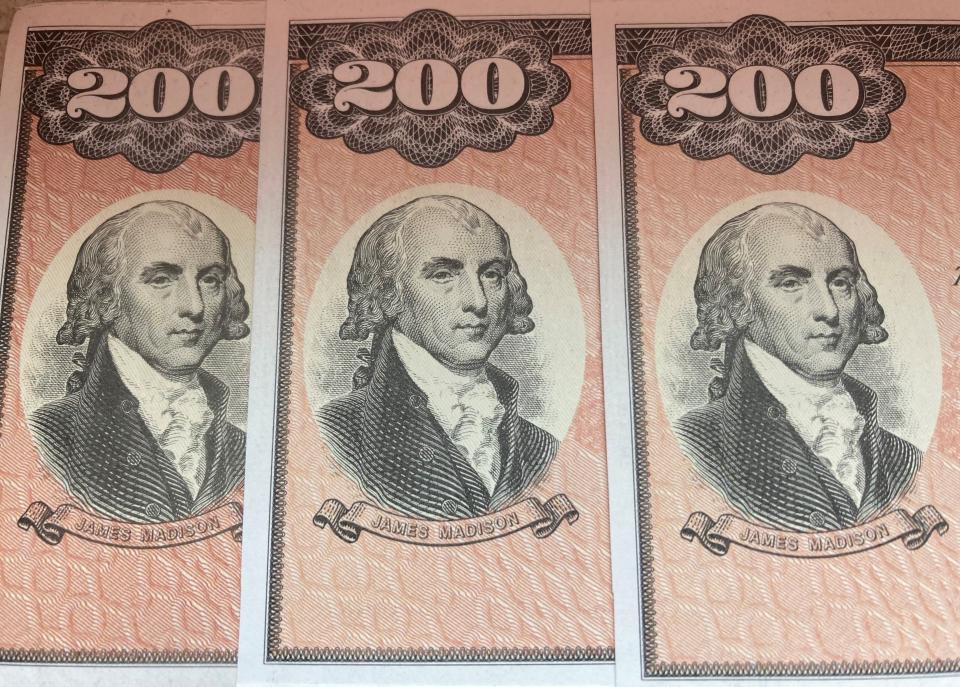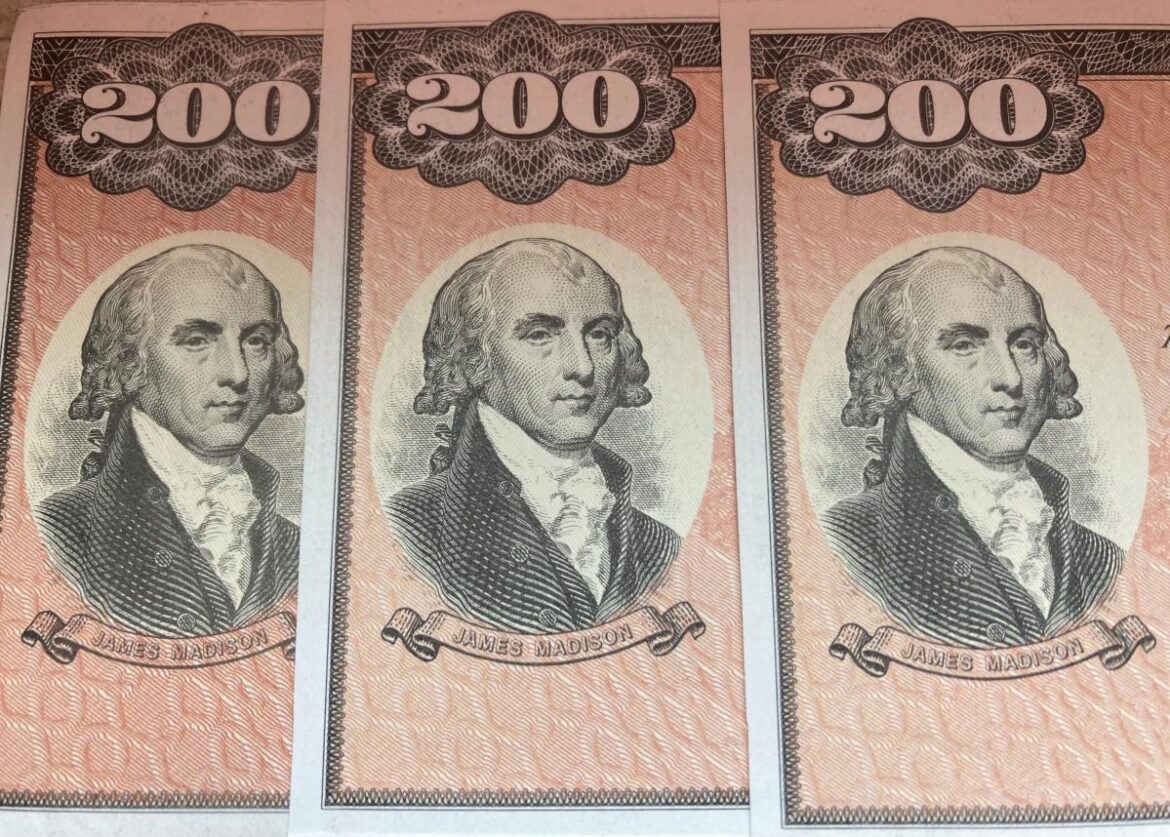Sure, we’ve heard of the feds seizing all sorts of shady items – glitzy Rolex watches, well-done counterfeit Louis Vuitton handbags, lookalike Gucci earrings.
Who would imagine, though, that crooks are cranking out anything as dull as counterfeit U.S. Savings Bonds? And that they’re hauling them to the bank to cash them?
Authorities claimed that $1 million in counterfeit savings bonds showed up at South Texas banks as part of one crackdown on a scheme to steal money by cashing phony savings bonds, including inflation-indexed or I Bonds, according to the U.S. Attorney’s Office for the Southern District of Texas.
Nationwide losses are estimated at over $50 million, according to an alert issued earlier this year by the Oklahoma Bankers Association.
Real savers run into real headaches
One reader complained to me that all her daughter wanted to do was cash one, legitimate Series EE savings bond for $5,000 when she was visiting home in Michigan. She had an account for many years. But the Chase bank wouldn’t let her cash the bond.
Chase told the Detroit Free Press, part of the USA TODAY Network, that it never stopped cashing savings bonds. Chase will cash U.S. savings bonds for customers who have banked with Chase for more than a year. But there are limits on how much in savings bonds can be cashed and how much money you can get on the spot.
“We offer up to $500 redemption value – purchase price plus interest – at all of our branches,” according to a spokesperson for Chase.
Otherwise, Chase customers and noncustomers would need to cash their savings bonds by mail through TreasuryDirect.gov.
Actual savers are finding it tougher in many cases to cash U.S. savings bonds at the bank after crooks cashed phony paper bonds in several states.
Many times, savers haul stacks of savings bonds, not just one or two bonds, to the bank to cash after decades of saving.
Back in the 1960s, 1970s and 1980s, workers regularly set aside money toward paper savings bonds from each paycheck through employer-sponsored payroll savings plans. People kept their paper bonds in everything from safe deposit boxes to shoe boxes or plastic bags.
We saw 401(k) plans enter the scene in 1978 and not every employer offered one. The U.S. Treasury stopped issuing paper savings bonds through traditional employer-sponsored payroll savings plans in 2011.
Many long-term savers only cash their bonds once they stopped earning interest after 30 years. Some lost track of their bonds and cashed them later. I remember taking my dear, hardworking, hard-saving mother to the bank, and, believe me, she often wasn’t cashing just one or two savings bonds.

Many banks once cashed savings bonds for non-customers but no longer do that. Huntington Bank, for example, stopped redeeming U.S. savings bonds for non-customers as of Feb. 16, 2022.
Last year, the Treasury allowed banks to stop cashing savings bonds for someone who wasn’t a customer or someone who is a new customer. Some banks now require that you be a customer for at least one year before being able to cash savings bonds.
Comerica Bank will cash U.S savings bonds – Series E, Series EE, and Series I – at banking centers for existing customers who have had accounts for more than six months. But new customers and non-customers are referred to the U.S., Department of the Treasury via the website TreasuryDirect.gov.
A bank can decline to cash that bond, too, if the bank has a reason to doubt the authenticity of the bond or is concerned about the ID or trustworthiness of the person cashing it.
About 88% of paper savings bonds are redeemed at banks, but banks have the option of refusing to redeem bonds in certain situations, according to a spokesperson for the Treasury’s Bureau of the Fiscal Service.
How does the savings bond scam work?
The bigger the face value, the tougher that savings bond could be to cash, in some cases. Scammers often try to pass off fake Series EE savings bonds that are in denominations of $5,000 or $10,000 each, according to an alert issued in February by the Oklahoma Bankers Association.
Criminals open a bank account, sometimes online. One person went to multiple branches and redeemed a few fake bonds at a time, according to the banking trade group. Some savvy tellers spot the fraud, but others don’t and that’s why banks are changing some rules.
We’re talking about a good deal of money even with one or two bonds. Interest builds and, for example, three old Series EE bonds with a face value of $5,000 each can add up to be worth more than $30,000 together.
Con artists might deposit the bond money into the account but then withdraw the money before the financial institution finds out, through the U.S. Treasury, that the savings bonds were fake. The Treasury later makes an adjustment that leaves the bank or credit union on the hook for the lost money.
One alert to credit unions noted that some employees used a TreasuryDirect.gov website to calculate the value of the bonds without realizing the tool doesn’t verify if the bonds are legitimate.
“The U.S. Treasury adjustments can take several days to weeks, which unfortunately aids the fraudster,” according to an alert last year by the CUNA Mutual Group, an insurance company that provides services to credit unions and others.
Counterfeit savings bonds trigger problems for banks
Banks are on the hook if they end up handing out cash when a counterfeit savings bond is redeemed, unless the Department of the Treasury can determine the financial institution was not at fault or negligent. The Treasury issued a 22-page booklet to banks, revised in October, that outlines various scenarios of when not to cash a bond.
Banks, for example, are told not to cash bonds if:
-
Any information on those bonds or notes has been altered.
-
Any noticeable irregularities appear, such as an odd texture or feel to the bond.
-
The bonds are mutilated or defaced in any way.
-
The person who is trying to cash the bonds seems suspicious or the bonds look suspicious.
Do not buy savings bonds from someone else or through an online auction site. “You cannot cash them,” according to TreasuryDirect.gov. “You can only cash savings bonds that you own or co-own unless you have legal evidence or other documentation that we accept to show you are entitled to cash the bond.”
While some of these counterfeit savings bonds look authentic, the Treasury warns the color of the counterfeit bond is more of “a pale-yellow or pale-peach color. Authentic bonds are a rich-peach color.”
Think about it, though, when is the last time you looked at a U.S. savings bond? Many tellers might not be familiar with how savings bonds should look. And the texture of real paper savings bonds issued over time isn’t the same across the board.
Some savers face a long wait for savings bond money
Go to your bank to cash your savings bonds and research your options.
I took an old $200 face value Series EE savings bond – now worth about $461 – to a regional bank where we have an account this week and they said they would cash it. (See TreasuryDirect.gov for a calculator to find out how much a paper bond is worth. You need to serial number and issue date of that bond to calculate it.)
One bond is one thing; a bigger batch of bonds could be another.
If you’re cashing 10 or more bonds at Huntington, for example, the teller or relationship banker might calculate the interest and redemption values within one or two business days. They’d call later to tell you the amount and ask you to return to endorse the bonds to redeem them, said Samantha Myers, communications manager for Huntington National Bank.
Given the levels of fraud, it’s logical that some banks changed their rules.
Unfortunately, the wait could take months, if you can’t find a bank to cash all of your bonds.
If the bank won’t cash your savings bond, you need to go to the TreasuryDirect.gov website to read instructions for cashing savings bonds by mail. You’re going to need to mail in the paper bonds and fill out an FS Form 1522 found online at TreasuryDirect.gov.
The form gives specifics, such as the Minneapolis post office box for mailing these bonds.
The TreasuryDirect site says online that it can take 13 weeks to process a claim to cash a savings bond. (If you’re trying to research missing bonds, the TreasuryDirect site notes that it will take at least six months to process.)
The average time it takes the Bureau of Fiscal Service to complete a simple bond redemption is about 25 business days, according to a bureau spokesperson. But he said it can take up to 13 weeks in the case of complex redemption cases.
“If a bondholder wishes to redeem their bond, we encourage them to start with their bank,” he said.
Waiting three months or more to get your money is distressing, especially if you expect to walk into a bank and cash a savings bond and get money on the spot.
Savers who need money quickly – say for a down payment on a home or college tuition – need to keep the new hurdles in mind. U.S. savings bonds bought in 1992 and earlier have stopped earning interest so you’d want to make sure to cash those bonds.
No one is going to send you any notice that your savings bonds need to be cashed or automatically redeem these bonds for you. It’s up to you to track your savings bonds.
Here’s another tidbit: If you run across an old Series HH savings bond sitting in a drawer, you need to know that the HH Bond cannot be cashed at all at the bank.
Savers who are cashing these specific paper bonds – which will stop paying interest after 20 years from the issue date – must have a bank account where the Treasury can send the money. The Treasury only redeems these HH Bonds via direct deposit. You’d also need to complete FS Form 1522 – giving instructions for direct deposit on that form.
If the HH bond is less than 20 years old, it is paying interest to you via direct deposit.
The Series HH bonds were sold from 1980 through August 2004 and are no longer being issued.
Contact personal finance columnist Susan Tompor: stompor@freepress.com. Follow her on Twitter @tompor.
This article originally appeared on Detroit Free Press: Nationwide savings bond scheme lead to headaches for savers, banks
